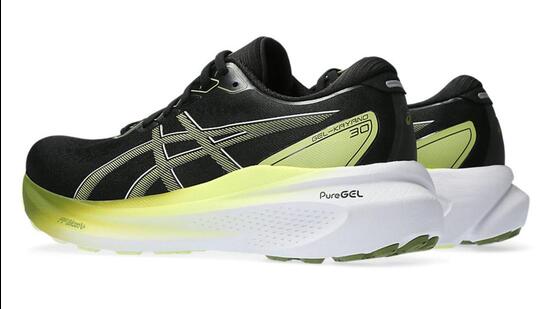Since running shoes are serious business, this restructuring shouldn’t really be a surprise. Asics have, in the 30th generation of the shoe, undertaken a significant shift in approach to the tech and design for the Gel Kayano series. For Asics Gel Kayano 30, the flagship running shoe for the Japanese sportswear company, the reboot incorporates material and design changes for what’s encapsulated as a “4D guidance system”, crucially without a significant increase in weight.

Does this mean it’ll appeal to a larger audience than before? It must, because within the running shoe stakes, a price tag of ₹15,999 pegs it in competition with Adidas Solarboost 5 (around ₹16,999) and the Puma Deviate Nitro 2 (around ₹15,999). The focus within this demographic isn’t only outright pace, but a heady balance of speed achieved by weight reduction, neutrality and comfort.
The fact that Asics has redone the basics of this running shoe, becomes quite apparent at first glance itself. There is still the distinct Asics’s family resemblance, but the midsole unit looks thicker, there is more headroom in the toe box and it looks more aerodynamic in comparison to its elder sibling.
Also read:Adidas Switch FWD’s innovation tweaks physics and the composition of foam
Despite weight reduction measures, the Gel Kayano 30 still tips the scales just around 303 grams. You’ll need to get used to this if you’re switching from an Adidas or a Nike pair. Just to illustrate the current landscape, the Adidas Adizero Pro 3.0 weigh around 238 grams, the Nike Vaporfly 3 a mere 181 grams. Those set the trend for the ecosystem. Perhaps another round of weight reduction may be in order for the next generation.
A new mesh makes the upper, which doesn’t seem to offer any extra ventilation in comparison with the 29, but there is a certain structural rigidity (particularly around the sides) which should be beneficial during runs. In particular, direction changes. There is a certain conventionality with the lacing mechanism, and as a runner, you need to simply find the sweet spot for the lock-in. In line with the observations from the outside, there seems a tad more space in the toe box.
There is a definite improvement in comfort as you wear the shoe for longer durations, mostly revolving around the added cushioning at just the right places. The new sockliner has something to do with it (also improves moisture reduction). Mind you, the Gel Kayano 30 feels broader and you may take a while to get used to that perceived bulk. The positive side of that, is stability and a planted feel – picking up pace, direction changes and dodgy grip on some surfaces.
Also read:Nike Vaporfly 3’s evolution as a matured running shoe doesn’t sacrifice speed
Beneath your feet reside the big tech and material changes, some visible and some not so much. There’s an iteration of the midsole foam which has shaved off a few grams, called FF Blast Plus Eco. This stack is higher (or thicker, depends on how you see it) by 4 millimetres than before. In terms of pure numbers, the foot sits at a height of 40mm at the heel and 30mm at forefoot. That’s a 10mmm difference, at par with most faster running shoes.
The height however, may take a while to get used to.
That also means, there is more cushioning between your feet and the running surface. Beneath the heel is the gel insert, which should absorb some of the impact from foot strikes during transitions. The advantages of which will become clearer as you run on different surfaces. However, some runners prefer the ‘sock-like’ feel and would want to get all the feedback from the surface they’re running on. The Gel Kayano 30 is instead appealing to a wider demographic, who’d have some criteria for comfort too.
Also read:Does tech help Nike Air Zoom Alphafly NEXT% set a new racing shoe benchmark?
These midsole changes are in sync with the outsole, which seems to have specific focus on shock absorption around the heel. While the thicker foam layer has its advantages, you’ll also be able to see some sculpting which Asics insists should help with energy redirection. Basically, with every transition from heel to toe as you run, this will compress and then release, to provide a certain push.
In the case of the Gel Kayano 30, that forward push assist felt more apparent when running on harder surfaces, but not so much on anything comparatively more in the doughy category.
With 30 years completed, what Asics has with the Gel Kayano 30 is the sort of longevity of legacy that rivals can scarcely match. For the last couple of generations, it was becoming clearer that there was the need for a radical redo of the Gel Kayano series. The tech had to keep up with the rivals. That’s happened, in some style, and these changes work well in sync. It’s a well thought out evolution, not just material changes to tick off a spec sheet.
There’s still work to be done, such as further weight reduction. Asics’ running shoes have always been a notch heavier than their counterparts, and with good reason. But the gap between the industry trends, and even the on-diet Gel Kayano 30 is too large to ignore. Yet, the huge step forward cannot absolutely be ignored.
